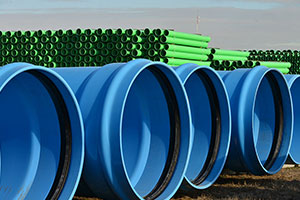PVC vs. Polypropylene Pipe
7/1/2015

With more than one million miles in service, PVC pipe has demonstrated proven performance for almost fifty years. PVC is used in over 85% of new installations, making it the material of choice for sanitary sewers. Solid-wall PVC sewer pipe is the standard by which other pipe types are measured. For this reason, information on PVC solid-wall pipe has been included along with PVC and PP profile pipes.
PVC Pipe - Long-Term Performance: Almost fifty years of unsurpassed reliability in sanitary sewer applications is backed by PVC sewer pipe standards that include: ASTM D3034, ASTM F679, ASTM F794, ASTM F949, and ASTM F1803.
Exceptional Joint Integrity: PVC sewer pipe joints meet the most stringent joint-tightness requirement: leak-free when tested at 25 feet of head per ASTM D3212. PVC pipe’s joint-tightness:
- Reduces groundwater infiltration, conserving costly treatment plant capacity
- Decreases sewage exfiltration, protecting the environment
- Prevents root intrusion, lowering maintenance costs
Stringent Acceptance Tests
Mandrel Testing - PVC Pipe Ensures a High Safety Factor: The PVC pipe industry and ASTM have long recommended mandrels that allow no more than 71⁄2% deflection of the PVC pipe diameter - which provides an installation safety factor of 4:1. Several PVC sewer pipe standards, like ASTM D3034, ASTM F679, and ASTM F949 include test mandrel diameters. PP profile-wall pipes have lower deflection capabilities so users should specify lower deflection levels to ensure the same degree of safety.
Air Testing: Low-pressure air testing should be performed on all sanitary sewer line installations. As a result of testing and research done since the 1950s, Uni-Bell’s UNI-B-06 Recommended Practice for Air Acceptance Testing of Sewer Pipe has become the industry benchmark. ASTM also provides material-specific standards for low-pressure air testing of sewer systems - while none measure up to UNI-B-06 for ensuring system tightness, ASTM F1417 is the most widely used of ASTM’s air-testing standards. Polypropylene has a 60% lower modulus of elasticity and is less resistant to creep, so standard low-pressure air testing may not give adequate assurance of long-term joint tightness.
Final Acceptance: Utilities often specify minimum waiting periods of 30 days before final acceptance of newly installed PVC sewer pipes. This deflection-versus-time testing is a proven method of ensuring proper design and installation of PVC pipe systems - verified by over 40 years of research and field experience. Until comparable testing and field evaluation are completed for PP pipe, users should not assume that mandrel and low-pressure air tests for PP provide the same assurance of installation quality as they do for PVC.
Other Considerations
Ensuring System Integrity with PVC Fittings: Unlike PP systems, PVC sewer pipe comes with a wide assortment of fittings available from many manufacturers. Joints using PVC fittings meet the same high performance requirements, since pipe joints and systems can easily be designed without the need for fittings that require cutting holes into the pipe. Sanitary sewer system water-tightness is achieved by avoiding cut-in fittings.
PVC for Challenging Design Applications: For difficult installations - where factors are present such as deep burial, poor soils, and high water tables - PVC pipe offers heavy-wall (higher-stiffness) pipe, as well as higher-stiffness and deep- socket fittings, which is not the case for PP.
Polypropylene Pipe - Caution Advised: The recent introduction of PP into the sanitary sewer market should be cause for concern to wastewater utilities for the following reasons:
- Unsupported claims about performance o Lack of rigorous studies and testing
- Questions regarding joint integrity
- Reduced safety factors
- Limited selection of fittings for connections
Sewer utilities should require piping products with a proven track record of performance. As municipalities and engineers attempt to reduce costs, consideration should be given to some of the significant differences between PVC and PP pipe materials.
To read more about PVC vs. Polypropylene; click here.